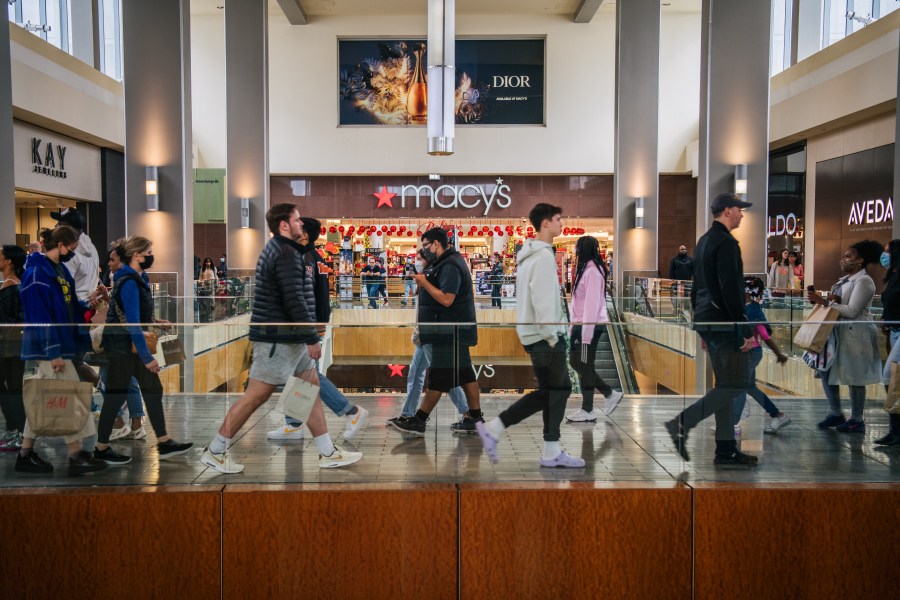What “made in the USA” really means

It’s the holiday season, and Americans are focused on shopping. One listener wonders what consumer spending looks like after a year of supply chain issues. We’ll also answer your questions about inflation and what qualifies as “made in America” on our last Whaddya Wanna Know Wednesday of the year!
Here’s everything we talked about on the show today:
- “Holiday Shopping 2021: Spending set to blow past records, NRF says” from CNBC
- “Clothing retailers flex pricing power and Wall Street is rewarding it” from CNBC
- “What Does ‘Buying American’ Even Mean?” from Wirecutter
- “What Does ‘Made in USA’ Actually Mean” from Business Insider
- “Auto Index | Kogod School of Business” from American University
New Investors Week: Your first donation to Marketplace goes TWICE as far with a dollar-for-dollar match from the Investors Challenge Fund! Give Now!
Make Me Smart December 8, 2021 transcript
Note: Marketplace podcasts are meant to be heard, with emphasis, tone and audio elements a transcript can’t capture. Transcripts are generated using a combination of automated software and human transcribers, and may contain errors. Please check the corresponding audio before quoting it.
Marielle Segarra: I’m just like, if I’m gonna pay this kind of rent, like move into a new place, pay that rent. I might as well like, be buying something.
Kai Ryssdal: Yeah. Oh yeah, no, I hear you. I hear that. It’s a big step, though, my goodness.
Marielle Segarra: I know.
Kai Ryssdal: Oh, my goodness. Here we go. Hey, everybody. I’m Kai Ryssdal. It’s a real estate advice show today. No, I’m just kidding. Not really. It’s, it’s Make Me Smart, making today make sense, though, on a Wednesday. Thanks for being with us.
Marielle Segarra: Yeah, and I’m Marielle Segarra, it is actually what do you want to know Wednesday. And that means it is time for us to answer listener questions. Our first one today is a question about inflation.
Jody: My name is Jody from Napa, California. And what I want to know is, if inflation is the process of too much money chasing too few goods, why is asking the public to consume less until we can get this whole scenario fixed never discussed?
Kai Ryssdal: Well, look, cause, cause Jody, it’s a little bit of a be careful what you wish for. And so here’s what we did. Marissa Cabrera, producer extraordinaire, got on the phone with economist John Lear at the Morning Consult and here’s what he had to say.
John Lear: To some extent, you know, imposing a ban on spending or trying to bring down the total level of spending is also going to have negative follow up, follow up effects in terms of decreasing job growth and wages.
Kai Ryssdal: So remember what happened–so two things to know. Number one is, and we say this at Marketplace all the time, spending by consumers or on behalf of consumers accounts for 70% of all economic activity in this country, right? So if you cut consumer spending, that is empirically not a good thing and you need to look no farther than example number two, which is the beginning of this pandemic, when we all stopped spending, and the economy went down the drain. And if you remember, there was job losses, there was GDP shrinkage, there was all kinds of stuff. So doing that is not necessarily the way to get out of it. The way to get out of it, honestly, is just wait. We just got to wait till it all works its way through, it’s, it’s like that big bulge in the Python and it’s eventually gonna hear work through but, but we’re in the middle of it, now, I’m telling you, I’m telling you.
Marielle Segarra: Yeah. And I mean, if you think about this from the retailer perspective, they make their decisions about what to buy going forward based on demand, what they think demand is going to be, what it is right now and kind of a historical perspective. So yeah, if they see demand is dropping, they’re gonna buy even less, you know, maybe even harder to get what you want going forward.
Kai Ryssdal: It gets messy, it gets messy in a big hurry. A big hurry. Okay, so more on consumer spending. This one about holiday shopping. Here you go.
JT: Hi, this is JT from Cedar Hill, Texas, the location of the highest concentration of radio towers in the United States. Everyone I know has been concerned about supply chain issues. So they bought their Christmas presents way early, including myself. Is that what’s fueling the increase in consumer spending that everyone’s so excited about right now? And is that going to go away? Are we not going to get the expected holiday spending that companies are used to? Thanks for making me smart?
Marielle Segarra: I feel like, JT, if we’re going to answer this question, you have to make us smart about why Cedar Hill, Texas has the most, the highest concentration of radio towers in the US, like that is very specific. Well,
Kai Ryssdal: I don’t, so it’s like, it’s in a, so, sorry, just some very quick googling here. Cedar Hill is in sort of North East, sort of North Central Texas, which might be flat. I don’t know. Elevation is 880 feet. So maybe it’s got some good–I don’t know. I don’t know. Fascinating.
Marielle Segarra: Very interesting. Well, we can answer your question, JT, which is holiday spending is actually on pace to set a record this year. And I think it was, yeah, the National Retail Federation said it’s expected to be up by as much as 11 and a half percent. spending is, in November in December of this year compared to last year. And I can think of a few reasons for that. One is actually inflation, right? Because those are raw numbers. So if it costs more–yeah.
Kai Ryssdal: Yeah, a dollar amount report. Yeah.
Marielle Segarra: Yeah. So if it costs more to get that, whatever present that you’re getting for your, your significant other and for your, your parents, and your total dollar spend is going to be up even if you buy the same number of things. And then also, you know, there’s, people are shopping early, as he pointed out, but one thing I was thinking about is if you shop early, it actually gives you more opportunities to spend because like, I’m picking up Christmas presents for my family all year, but I forgot I had them.
Kai Ryssdal: Really? My mom used to do that. Wow.
Marielle Segarra: Yeah, if I see something I think they’ll like, like I bought, I bought my mom some stuff this summer and then, and my brother and like, I bought some stuff, I don’t know, a couple weeks ago, and I forgot I even had it. So then I just bought some more stuff. And it just leads to kind of a rolling holiday shopping season and then more impulse buys.
Kai Ryssdal: And then two years later, my mother would pull something out of the closet and go oh, yeah, this was for Christmas, three years ago. What are you doing? What are you doing?
Marielle Segarra: Yeah. I have a hard time not giving some–if I buy you present in like, July, it’s hard to hold on to it until December because it’s like, you get excited about giving the person the thing, like it made you think of them, you know? So sometimes I gift early. Okay. Well, our next question is about manufacturing.
Joe: Hey, guys, this is Joe, in the military stationed in Korea. And I had a question on your recent episode on onshoring. And my question is, what constitutes domestically made with regard to the trade balance? For example, if, if I’m Ford and I send all the parts manufacturing overseas, and then I assemble the car in the United States, is that domestically manufactured?
Kai Ryssdal: Yeah, that’s a really, really good question. So, the Census Bureau tracks foreign trade, first of all, so we’ve gone to them for the source. This is Marque and Marissa and Grace, who have, you know, done the homework on this one. Here’s the deal. The Census Bureau defines domestic goods as, and this is a, quote, “commodities that are grown, produced or manufactured in the United States.” The definition also includes items that were “previously imported and are further manufactured or processed in the United States, or have been enhanced in value, or changed from their original form.” So that’s the overall thing. But with cars, it’s really, really hard because the USMCA, right, which is the successor to NAFTA that President Trump negotiated, established new guidelines, many of which include automobiles because automobile, automobile parts or sections, I suppose, go back and forth across those borders I can’t even tell you how many times. So cars, under the USMCA, have to meet a 70 to 75% “North American content requirement,” that is to say percentage of the cars materials manufactured in the United States of America. So it can be manufactured and assembled in Mexico, sold in the States and counted as a domestic good, so it’s really, really, really hard. Really hard. Really hard.
Marielle Segarra: Yeah, there’s not one like, straight answer to that. Right. And apparently, those, those labels, those made in America labels, are, there’s a clear definition for them, but it’s not really enforced. So just because you see a product advertised as Made in the USA, doesn’t mean it actually was. Like, the FTC doesn’t, doesn’t really do anything about it.
Kai Ryssdal: Yeah. And then there’s this whole Buy America thing that all presidents and administrations like, tout as a, hey, we’re gonna help American domestic manufacturers and all this jazz. Turns out, it doesn’t always do that. And it raises costs and is a little bit of a two-edged sword. So the whole you know, what’s made in America and how that’s counted is like a PhD thesis or three, is what I’m saying.
Marielle Segarra: Yeah, there was a New York Times story about like this Buy American label. And it was so interesting. They referenced the first president, George Washington, his, that his inauguration, he chose homespun fabric that was made in America, not imported from England, to wear. So this goes all the way back, all the way back.
Kai Ryssdal: Setting precedent with everything he does, I heard that somewhere. Anyway, so send us more questions because we’re out of questions. We need yours. You can send them to us, makemesmart@marketplace.org. But before we go, a super quick word about fundraising. We have told you about new investors week, if you’ve never donated to Marketplace or Make Se Smart before, this is your time. Our investors challenge fund is going to hook you up, matching you dollar for dollar. We’d appreciate, obviously, anything you can do. You all are so generous to us and we appreciate it and, and we come to you every now and then and we only do it because we need it. That’s the fact, we only do it because we need it.
Marielle Segarra: Alright, that’s it for us today. That is our last Wednesday show, actually, of 2021. But we’ll be back tomorrow for hollowed out shell Thursday. I’m going to set an intention that I don’t want to be hollowed out tomorrow.
Kai Ryssdal: I’m just gonna say, you have to go where the podcast leads you. I’m sorry. I think you have to go where the podcast leads you.
Marielle Segarra: Even for the rest of the day I have to be hollowed out?
Kai Ryssdal: Well, no, you just, you just need that 15 minutes. That’s the only thing, you have to go where the podcast leads you and if it’s, if it’s okay, it’s okay, if it’s not, you know, that’s what it is. Anyway, reruns start next week. We’re here Thursday, Friday this week, reruns next week. Send us your questions, would you? Makemesmart@marketplace.org. Leave us a voicemail, number is 508-827-6278, 508-UB-SMART. Hook us up and tell us what you think or what’s on your mind or what you want to know. Sorry, just wait, just wait. Okay, here we go. Today’s episode of Make Me Smart was produced by Marissa Cabrera and Marque Greene. Charlton Thorpe with the engineering down at the studios in LA. Grace Rubin is our intern.
Marielle Segarra: Ben Tolliday and Daniel Ramirez composed our theme music, and our senior producer is Bridget Bodnar.
Kai Ryssdal: She’s off today, she’s flying with two children under the age of four to go home to Michigan. Holy cow, Bridget. Yeah, I know, we were talking about it yesterday. Today was a rough day.
Marielle Segarra: They’re sweet, though. They’re sweet children.
Kai Ryssdal: Yes, until you put them on an airplane for like, four hours.
Marielle Segarra: And the screaming begins.
Kai Ryssdal: One can only hope they sleep or something, I don’t know.
None of us is as smart as all of us.
No matter how bananapants your day is, “Make Me Smart” is here to help you through it all— 5 days a week.
It’s never just a one-way conversation. Your questions, reactions, and donations are a vital part of the show. And we’re grateful for every single one.


















